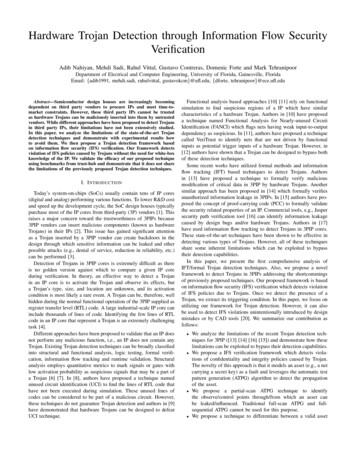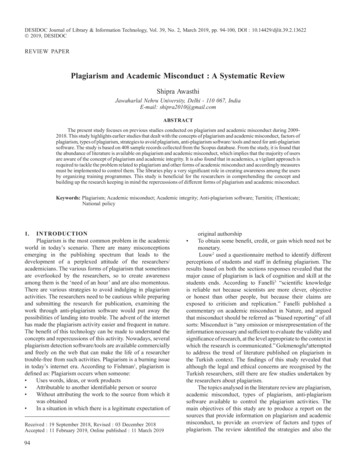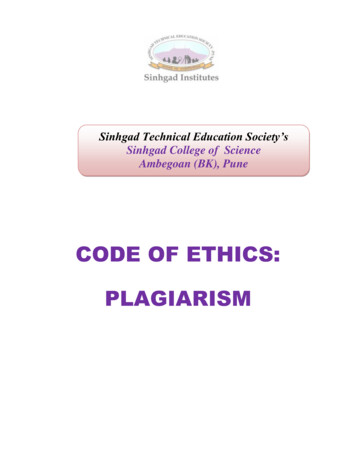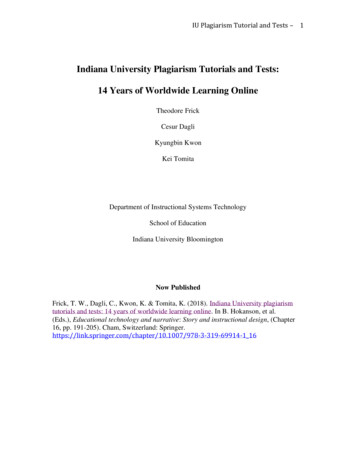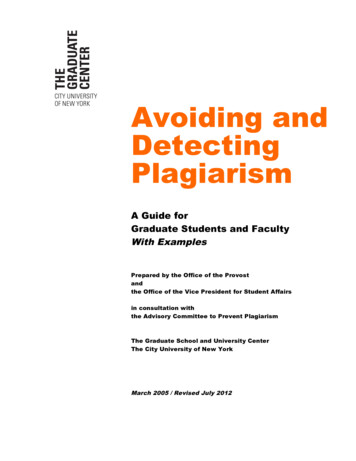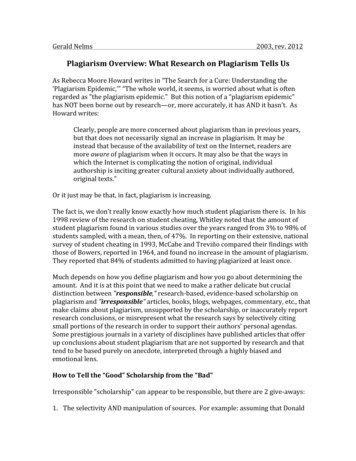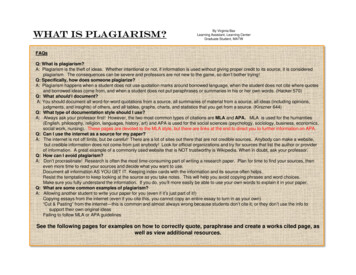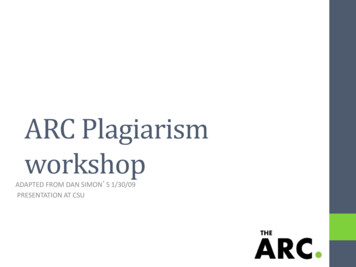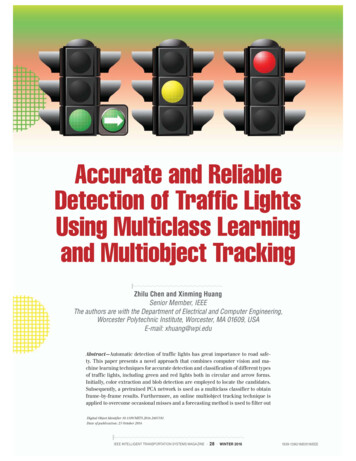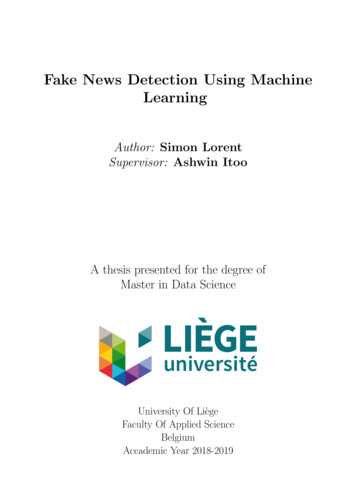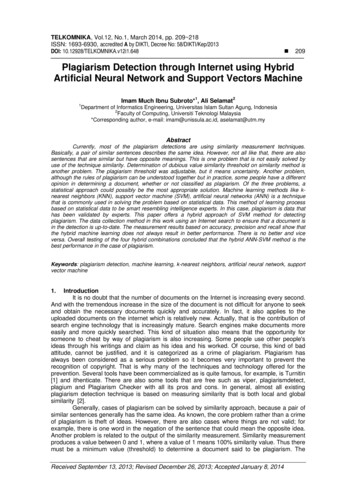
Transcription
TELKOMNIKA, Vol.12, No.1, March 2014, pp. 209 218ISSN: 1693-6930, accredited A by DIKTI, Decree No: 58/DIKTI/Kep/2013DOI: 10.12928/TELKOMNIKA.v12i1.648 209Plagiarism Detection through Internet using HybridArtificial Neural Network and Support Vectors Machine1Imam Much Ibnu Subroto*1, Ali Selamat2Department of Informatics Engineering, Universitas Islam Sultan Agung, Indonesia2Faculty of Computing, Universiti Teknologi Malaysia*Corresponding author, e-mail: imam@unissula.ac.id, aselamat@utm.myAbstractCurrently, most of the plagiarism detections are using similarity measurement techniques.Basically, a pair of similar sentences describes the same idea. However, not all like that, there are alsosentences that are similar but have opposite meanings. This is one problem that is not easily solved byuse of the technique similarity. Determination of dubious value similarity threshold on similarity method isanother problem. The plagiarism threshold was adjustable, but it means uncertainty. Another problem,although the rules of plagiarism can be understood together but in practice, some people have a differentopinion in determining a document, whether or not classified as plagiarism. Of the three problems, astatistical approach could possibly be the most appropriate solution. Machine learning methods like knearest neighbors (KNN), support vector machine (SVM), artificial neural networks (ANN) is a techniquethat is commonly used in solving the problem based on statistical data. This method of learning processbased on statistical data to be smart resembling intelligence experts. In this case, plagiarism is data thathas been validated by experts. This paper offers a hybrid approach of SVM method for detectingplagiarism. The data collection method in this work using an Internet search to ensure that a document isin the detection is up-to-date. The measurement results based on accuracy, precision and recall show thatthe hybrid machine learning does not always result in better performance. There is no better and viceversa. Overall testing of the four hybrid combinations concluded that the hybrid ANN-SVM method is thebest performance in the case of plagiarism.Keywords: plagiarism detection, machine learning, k-nearest neighbors, artificial neural network, supportvector machine1.IntroductionIt is no doubt that the number of documents on the Internet is increasing every second.And with the tremendous increase in the size of the document is not difficult for anyone to seekand obtain the necessary documents quickly and accurately. In fact, it also applies to theuploaded documents on the internet which is relatively new. Actually, that is the contribution ofsearch engine technology that is increasingly mature. Search engines make documents moreeasily and more quickly searched. This kind of situation also means that the opportunity forsomeone to cheat by way of plagiarism is also increasing. Some people use other people'sideas through his writings and claim as his idea and his worked. Of course, this kind of badattitude, cannot be justified, and it is categorized as a crime of plagiarism. Plagiarism hasalways been considered as a serious problem so it becomes very important to prevent therecognition of copyright. That is why many of the techniques and technology offered for theprevention. Several tools have been commercialized as is quite famous, for example, is Turnitin[1] and ithenticate. There are also some tools that are free such as viper, plagiarismdetect,plagium and Plagiarism Checker with all its pros and cons. In general, almost all existingplagiarism detection technique is based on measuring similarity that is both local and globalsimilarity [2].Generally, cases of plagiarism can be solved by similarity approach, because a pair ofsimilar sentences generally has the same idea. As known, the core problem rather than a crimeof plagiarism is theft of ideas. However, there are also cases where things are not valid; forexample, there is one word in the negation of the sentence that could mean the opposite idea.Another problem is related to the output of the similarity measurement. Similarity measurementproduces a value between 0 and 1, where a value of 1 means 100% similarity value. Thus theremust be a minimum value (threshold) to determine a document said to be plagiarism. TheReceived September 13, 2013; Revised December 26, 2013; Accepted January 8, 2014
210 ISSN: 1693-6930judgment of the plagiarism is difficult to do, although it could be done with the survey or themeasurement precision and recall. Indeed, the advantages can be carried adjustment, but italso could be due to a deficiency point uncertainty. Another common problem is the definition ofplagiarism that existed at the intersection. Inconsistency occurs expert in judging a case isconsidered plagiarism. Once a case is regarded as plagiarism, while in other very similar casesregarded as not plagiarism. In our opinion, all of three problems may be solved by a statisticalapproach. Much machine learning can be a solution to the statistical problem.This paper offers a different approach that is machine learning. Machine learning is aclassifier based on learning system using empirical data, which have been validated by experts.Based on the learning results will be obtained by a set of mathematical formulas with fewconstants, and variables are referred to as a model. Furthermore, this is considered a model ofintelligence and will be used in general to classify cases other.Consideration of machine learning approach is based on the assumption that althoughthe theory of plagiarism has been understood by the experts, but in reality, they often differ inthe same case. For example, a sentence that has a certain resemblance interpreted as aplagiarism by an expert, but it turns out; there are other experts disagree with regard not asplagiarism. For example, there are two very similar sentences in the text but one of themcontains the word "not". The word "not" of course meaning is the opposite or no different thanthe "not" its. This can be confusing. This is just one example of the many examples of inequalityperceptions of plagiarism. With accommodate these differences are expected to machinelearning approaches could be the solution.In general, the source used in the detection of plagiarism comes from two differentsources. The first source is the primary repository that has built itself where all documents arecollected, processed, and indexed so that it becomes easy and suitable for the purpose ofdetecting plagiarism. The second source is derived from secondary sources that the searchengines are already proven mature like google, yahoo and others. The first source would befaster in the detection process but requires a resource that is large enough to hold the data thatis very large and very fast growing. Turnitin is the one that uses this type of source. While thesecond source is a bit slow in the detection process for using secondary data and existence ofadditional processes to ensure cases of plagiarism. However, both types of sources are betterable to detect new uploaded documents on the internet because it is generally owned by thesearch engine crawler is able to update the documents quickly. With these advantages inaddition to the resources used in this experiment is the second kind of the Internet.2.Machine Learning and Similarity ApproachMost of the existing techniques in detecting plagiarism using the similarity measurementapproach. This technique is actually similar to the technique used in information retrieval (IR) isto determine the rank retrieval based on measuring the similarity to a query.The similarity-based plagiarism detection can be divided into three groups, namely textbased similarity (Cosine, fingerprint, etc.)[3, 4], graph similarity (ontology, etc.)[5, 6], and linematching (bioinformatics, etc.)[7]. All techniques are based on similarity measurements thatreturn a degree value of similarity from 0 to 1. A value equal to 1 is the greatest value of themean level of similarity is 100%, the smaller value means getting away from a similar thing. Theproblem is the number of how many digits an appropriate degree of similarity can be regardedas plagiarism? Value of 90% may be considered as the minimum threshold of plagiarism butcould also 95% if you want a higher level of similarity as a category of plagiarism. It means themeasurement of the similarity-based plagiarism requires similarity threshold adjustment [8].However, the threshold value is not required in the machine learning approach. Thelevel of similarity in machine learning has been never visible because of plagiarism decisiondepends on the outcome of learning from the experts that have been presented in a numericvalue. Experts have been asked to assess a number of comparisons couple sentences, andthen he had to determine whether it is in the category of plagiarism or not. The decision data willbe an intelligence of machine learning.Several machine learning techniques that has proven its performance are k-NearestNeighbors (KNN), Support Vector Machine Learning (SVM), and Artificial Neural Network(ANN). KNN is a simple theory but has proved very good accuracy. This technique willcategorize a member of X based on its nearest neighbors. The number of nearest neighbors (n)TELKOMNIKA Vol. 12, No. 1, March 2014 : 209 – 218
TELKOMNIKAISSN: 1693-6930 211which determines the classification results are generally more than one but also not be toomuch. To optimize the accuracy of the variation in the value of n needs to be tried. If X hassome neighbors are mostly in the category of plagiarism then X is a member of plagiarism, andvice versa. Although KNN has a high accuracy but this technique is slow because of highcomputing to calculate the distance to all neighbouring members. That is why this technique isalso known as lazy classifier.SVM is a classifier that also proven has good performance, especially in cases relatedto text. This technique is based on a statistical approach. Basically, the formula of this techniqueis to find the boundary between the two classes. The learning technique is to find an optimalthreshold for each class with the goal furthest from the two boundaries.The set of coordinates that determining boundary is exactly hereinafter called thesupport vectors. In this case the two classes plagiarism are plagiarism class and not plagiarismclass.ANN is a learning classifier based on the amount of data by modeling the brain workswith mathematical models, in this case the data plagiarism and non-plagiarism. The workings ofthis machine refer to the relationship between neurons with other neurons in the other layer.Mathematically, a function neuron networkis defined as the composition of other functions. This in turn can be defined as a function of composition between interdependent. It reallydepends on how the network structure is designed that describes the relationship between thedependency. In general, the most widely used is the nonlinear weighted sum as in the formulabelow. Where K is the activation function, for example using the hyperbolic tangent, as simply a, , ,.vector (1)A common use of the phrase ANN model really means the definition of a class of suchfunctions (where members of the class are obtained by varying parameters, connection weights,or specifics of the architecture such as the number of neurons or their connectivity).Some hybrid method proved successful in improving performer in some cases, such asKNN hybrid language for detection [9].Work in this paper will prove that the only cases of plagiarism cannot be solved bysimilarity measurement approaches but also can be solved by machine learning approaches.This paper will show the experimental results of three single learning machines KNN, SVM andANN like some hybrid of the single engine is. The purpose of the hybrid is to get a betterperformance than a single machine, especially on plagiarism cases.3.Plagiarism Data RepresentationA sentence generally contains an idea that will be delivered[10]. It is common in naturallanguage. This reason is strong enough to construct machine learning algorithms based on acomparison of the level of the sentence.The data is taken from a comparison of the query sentence with another sentence,which is the result of an Internet search. From the data of the search results are then validatedby experts who understand the definition of plagiarism category well. With this method of datacollection as we expect the experimental results are not much different from that resulting at thetime of real application of Internet-based plagiarism detection. Figure 1 summarizes thevalidation process starts with the collection of data with the sample input document in astandard format PDF, DOC and TXT. After going through the process of pre-processing willproduce a bunch of sentences that will be validated by experts. Experts mark next section forsuspected plagiarism and what is not suspected further.Including unnecessary suspicion is the bibliography, the phrase in quotation marks,numeric data, images, and special characters that do not form a sentence. Data validation resultis beneficial for the filter engine to throw in a process that does not detect plagiarism asmentioned above. Output of this process is a collection of sentences that will be used as aquery in a search engine to find some sentences potential plagiarism.Plagiarism Detection through Internet using Hybrid Artificial (Imam Much Ibnu Subroto)
212 ISSN: 1693-6930Figure 1. Plagiarism ValidationPre-processingData sentence validated by experts further processed with the tokenization. Generally,the processing of a sentence using the standard text in natural language programming (NLP) isa word stemming and stopping removal. Synonym search process is also applied in this work.As to the machine learning data are represented in the vector space model (VSM). It isstandard techni
[1] and ithenticate. There are also some tools that are free such as viper, plagiarismdetect, plagium and Plagiarism Checker with all its pros and cons. In general, almost all existing plagiarism detection technique is based on measuring similarity that is both local and global similarity [2].
